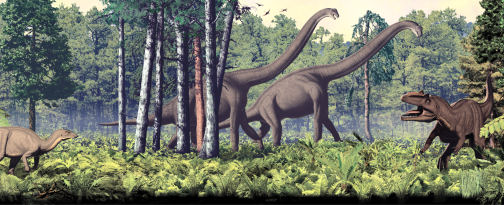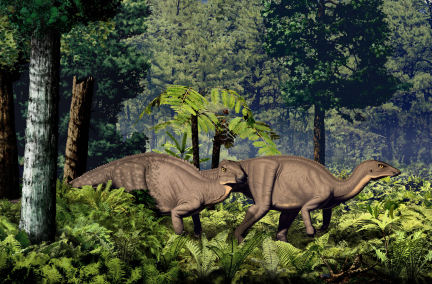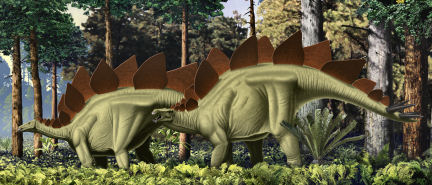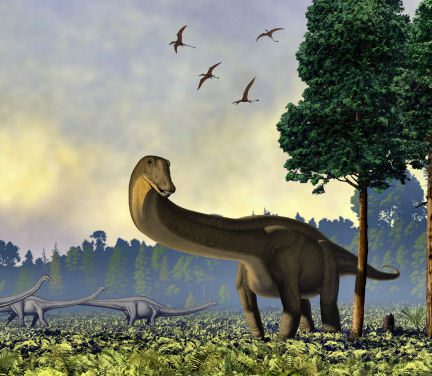Hall of Dinos
If you live near Pittsburgh or befall to travel there, you might want to swing by the Carnegie Museum of Intelligent History. On November 21, the museum undraped the largest dinosaur mural in the world.
The painting is 180 feet (55 meters) foresightful and an average of 15 feet (4.6 m) tall. Information technology wraps around terzetto of the four walls of the museum's dinosaur halls.
 |
| This mural, the largest dinosaur picture in the world, depicts species that lived in the western United States 150 trillion years ago. |
| All images courtesy of Walters & Kissinger, LLC. |
All the dinosaurs shown in the mural lived about 150 million years ago in the western United States. Scientists have base fossils of each species in layers of rock that stretch from Wyoming to New Mexico. This group of rocks is called the Morrison formation.
The enormous picture is true to life in other shipway too. When these dinosaurs were alive, grasses and flowering plants hadn't yet evolved. So, the mural depicts an environment full of trees and ferns. In the background, you can see flying reptiles and a chipmunk-sized burrowing mammal known as Fruitafossor.
 |
In the foreground are two members of the genus Camptosaurus (shown in the close-up above). These herbivores, or plant eaters, sometimes walked on two legs. Adults could grow longer than 26 feet (8 m), from the tips of their snouts to the tips of their tails.
 |
The divider too features two Stegosauruses (shown above). These stocky, spiky, bus-size creatures Ate only plants.
 |
This section of the divider shows an Apatosaurus, unmatched of the largest animals that ever lived on land. Adults averaged 75 feet (23 m) long, and weighed about 25 tons (50,000 pounds). These long, slim dinosaurs were herbivores.
The mural is part of a major expansion of the Carnegie museum's dinosaur halls, says Matt Lamanna, helper conservator of craniate paleontology. Two artists who specialize in painting prehistoric scenes, Robert F. Walters and Tess Kissinger, created the huge cyclorama. They as wel colorful several other brand-new murals at the museum.
Walters remembers sightedness the world's second-longest dino mural along a clip report when he was 4 age old. That painting is 110 feet long and 16 feet (4.9 m) tall. IT is displayed at the Yale Peabody Museum in New Haven, Conn., where artists painted it between 1943 and 1947.
After seeing the Yale mural, Walters knew what helium wanted to do when he grew up. Soon, he started draftsmanship dinosaurs. The new partition is his latest skill.
"We've been working on this divider for 2 years," says Walters. "The fact we've varicolored a record surf is meet starting to go down in."—Emily Sohn
Going Deeper:
Perkins, Sid. 2007. Huge, yet not quite sprightliness-sized. Skill News program 172(Nov. 17):308. On hand at hypertext transfer protocol://www.sciencenews.org/articles/20071117/fob3.asp .
To lear ongoing renovations of the Carnegie Museum of Natural History's dinosaur exhibits, as well as download prison term-lapse videos of the reassembly of around of the museum's larger dinosaur skeletons, attend www.carnegiemnh.org/dinosaurs/cam.htm.
To see more images of prehistoric life by Robert F. Walters and Tess Kissinger, go to www.dinoart.com/.

0 Response to "Hall of Dinos"
Post a Comment